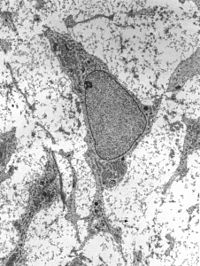
Photo from wikipedia
Human embryonic stem cells (hESCs) and induced pluripotent stem cells (iPSCs) can be differentiated into cardiomyocytes (hESC-CMs and iPSC-CMs, respectively), which hold great promise for cardiac regenerative medicine and disease… Click to show full abstract
Human embryonic stem cells (hESCs) and induced pluripotent stem cells (iPSCs) can be differentiated into cardiomyocytes (hESC-CMs and iPSC-CMs, respectively), which hold great promise for cardiac regenerative medicine and disease modeling efforts. However, the most widely employed differentiation protocols require undefined substrates that are derived from xenogeneic (animal) products, contaminating resultant hESC- and iPSC-CM cultures with xenogeneic proteins and limiting their clinical applicability. Additionally, typical hESC- and iPSC-CM protocols produce CMs that are significantly contaminated by non-CMs and that are immature, requiring lengthy maturation procedures. In this review, we will summarize recent studies that have investigated the ability of purified extracellular matrix (ECM) proteins to support hESC- and iPSC-CM differentiation, with a focus on commercially available ECM proteins and coatings to make such protocols widely available to researchers. The most promising of the substrates reviewed here include laminin-521 with laminin-221 together or Synthemax (a synthetic vitronectin-based peptide coating), which both resulted in highly pure CM cultures. Future efforts are needed to determine whether combinations of specific purified ECM proteins or derived peptides could further improve CM maturation and culture times, and significantly improve hESC- and iPSC-CM differentiation protocols.
Journal Title: Bioengineering
Year Published: 2022
Link to full text (if available)
Share on Social Media: Sign Up to like & get
recommendations!